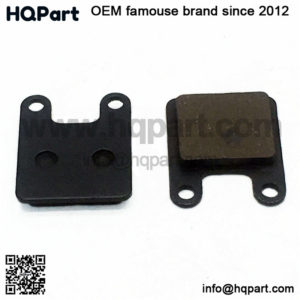1. Speed Is The Enemy
When it comes to braking, full and complete stops from a high speed are absolutely the #1 cause of premature brake pad wear. Speed causes wear on brake pads exponentially – that is, coming to a full stop from 105 kph rather than 85 kph forces the brakes to dissipate 33% more energy.
Brake pads work by transforming energy into heat – and this means they become worn out more quickly the more energy they have to dissipate. If you slow down just a little bit, you can save quite a bit of wear and tear on your brake pads.
2. Never “Two-Foot” Your Pedals
This is Driver’s Ed 101 – but you should avoid “two-footing” your pedals. If you tend to tap your brake pedal with your left foot while still keeping your right foot on the accelerator, this is a bad habit. It leads to more “brake taps” which don’t’ really do anything to stop your car, and cause premature wear.
3. Coast More You Can
Consider paying more attention to the flow of traffic, and stopped or slowed-down cars that are ahead of you, and coast whenever you can to lower your speed – as opposed to braking.
Going uphill is a great example of this. If you’re driving uphill towards stopped cars, why bother braking before you crest the hill? Simply coast up, and lose some speed, then brake when you really need to.
Or, if you’re going on a freeway off-ramp, just coast from 120 kph to 80 kph, and then press the brakes to slow down the rest of the way. Doing so will seriously extend the lifetime of your brake pads.
4. Don’t “Hurry Up To Stop”
This advice will help you save on gas, as well as on brake wear and tear. Is there a red light or a stop sign coming up? Start coasting and slowing down!
There is absolutely no reason to step on the gas and “hurry up to stop” when the cars ahead of you are clearly not moving. All you’ll do is waste fuel – and when you do have to stop, you’ll put excessive wear and tear on your brake pads.
5. Keep Your Car As Light As Possible
Most people don’t keep heavy objects in their car, but if you tend to keep a lot of stuff in your car, that weight can add up – and lead to a larger kinetic load that your brake pads must halt when you stop.
This doesn’t just apply to objects in your car, either. Aftermarket stereo systems, body panels, wheels, and other customizations can make your car much heavier – resulting in shorter brake pad life.
6. Flush Your Brakes Every 2 Years
Your brakes should be bled and flushed about every 2 years, especially if you have an older car. This will help your brakes work more effectively, and make your internal components work longer.
This is because brake fluid naturally attracts water. During emergency braking or repeated brake use, this moisture can “boil”, reducing braking effectiveness. Moisture can also cause internal corrosion, reducing the lifespan of brake components like rubber seals.
“Keyword”
“how brake pad are made”
“how to check brake pad thickness”
“how to measure brake pad thickness”
“how to install brake pad retaining clip”
“how much is brake pad replacement”
“how much is a brake pad change”
“how much does brake pad replacement cost”
“how to reset brake pad sensor on bmw”
“how to check brake pad wear”
“how brake pads are made”
“how brake pads and rotors”
“how long do brake pads last”
“how to change brake pads”
“how to check brake pads”
“how much do brake pads cost”
“how much does it cost to replace brake pads”
“how much brake pads cost”
“how to reset check brake pad wear mercedes”
“how much is brake pad and rotor replacement”

